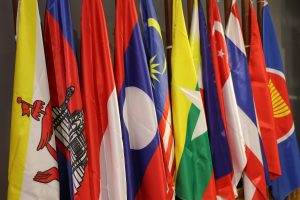The Association of Southeast Asian Nations (ASEAN) today began a five-day joint military exercise in Indonesian waters, amid growing tensions in the nearby South China Sea.
The ASEAN Solidarity Exercise, which runs until September 23, will involve all 10 ASEAN member states plus Timor-Leste, which recently applied to join the Southeast Asian bloc. The drills will focus on maritime security, disaster response, and rescue operations rather than combat exercises.
In announcing the exercise back in June, Indonesian military chief Yudo Margono said that that it was “about ASEAN centrality.”
While ASEAN has held joint military exercises with the United States and other partners, this week’s exercise is the first involving the current and prospective members of the bloc.
Lt. Col. Abidin Tobba, the media coordinator for the ASEAN Solidarity Exercise, told BenarNews that the exercises will take place around Batam island, which is located adjacent to Singapore on the eastern approach to the Strait of Malacca. “Eleven countries and hundreds of personnel will take part in the exercise,” Abidin said.
The exercises were initially scheduled to take place in the North Natuna Sea – Jakarta’s name for the portions of its exclusive economic zone (EEZ) surrounding the Natuna Islands, portions of which fall within China’s expansive “nine-dash line” maritime claim over most of the South China Sea.
While Jakarta says that is not a formal claimant in the maritime and territorial disputes that have roiled the important waterway in recent years, it has periodically protested the incursions of Chinese fishing boats and coast guard vessels into its EEZ. Indeed, the situation prompted Jakarta to rename the area the “North Natuna Sea” in 2017. As such, the holding of joint ASEAN drills in waters claimed by the Chinese government would have sent a signal of regional unity in the face of Beijing’s claims.
Perhaps for this reason, Indonesia announced in June that the drills were being shifted into undisputed waters close to Batam. An Indonesian military spokesperson said that the new location was better suited to conducting disaster relief operations. “This exercise is focused not on combat, so it is best suited for the south that is in direct contact with the people,” the spokesperson was quoted as saying.
However, some reports suggested that the shift took place due to intra-ASEAN disagreements about whether to hold the drills in areas involved in maritime disputes with China. In particular, some claimed that Cambodia had opposed holding the drills in disputed waters out of fear that it would damage ASEAN-China relations. In the past, Cambodia’s government, perhaps China’s closest partner in Southeast Asia, has been accused of stymying the establishment of unified ASEAN position on the South China Sea disputes.
Nonetheless, the fact that ASEAN has managed to organized a joint maritime exercise of any kind, even if it comes more than a decade after Beijing began asserting its expansive claims over the South China Sea, is a welcome development on an issue that has for years divided the bloc. It also offers something to build on in the years to come.

































